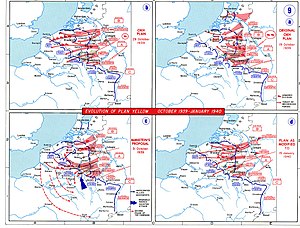Manstein Plan
| Manstein Plan/Fall Gelb (Case Yellow) | |
|---|---|
| Part of the Second World War | |

Clockwise: Evolution of plans for German: Fall Gelb Case Yellow, the invasion of France and the Low Countries
|
|
| Operational scope | Strategic |
| Location |
South-west Netherlands, central Belgium, northern France Coordinates: 50°51′00″N 04°21′00″E / 50.85000°N 4.35000°E |
| Planned | 1940 |
| Planned by | Erich von Manstein |
| Commanded by | Gerd von Rundstedt |
| Objective | Defeat of the Netherlands, Belgium and France |
| Date | 10 May 1940 |
| Executed by | Army Group A |
| Outcome | Victory |
The Manstein Plan is one of the names used to describe the war plan of the German Army during the Battle of France in 1940. The original invasion plan was a compromise devised by Franz Halder and satisfied no-one. Some documents containing details of the plan fell into Belgian hands during the Mechelen incident of 10 January 1940 and the plan was revised several times. The versions of the plan increased the emphasis of an attack by Army Group A through the Ardennes, which progressively reduced an offensive by Army Group B through the Low Countries to a diversion.
By coincidence, in the eventual version of the plan, the main effort of the German invasion was made against the Ardennes, the weakest part of the Allied line, where defence was left to second-rate French divisions, while the Seventh Army, the most powerful part of the French strategic reserve, was committed to an attempt to join with the Dutch Army far to the north, in the Breda variant of Plan D, the Allied deployment plan.
The Manstein Plan was a counterpart to the French Dyle Plan for the Battle of France. Lieutenant General Erich von Manstein dissented from the 1939 versions of Fall Gelb (Case Yellow), a plan for an invasion of France and the Low Countries, devised by Franz Halder. The original Aufmarschanweisung N°1, Fall Gelb (Campaign Instruction No 1, Case Yellow), was a plan to push the Allied forces back through central Belgium to the Somme river, in northern France, with similarities to the 1914 campaign of the First World War. On 10 January 1940, the Mechelen Incident occurred, when a German aircraft carrying documents with parts of the operational plans for Fall Gelb crashed in Belgium, prompting another review of the invasion plan. Fall Gelb was revised by Halder, not fundamentally changing it in Aufmarschanweisung N°3, Fall Gelb, Manstein was able to convince Hitler in a meeting on 17 February, that the Wehrmacht strategy should be an attack through the Ardennes, followed by an advance to the coast.
...
Wikipedia
